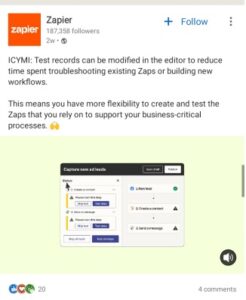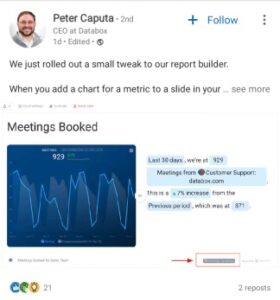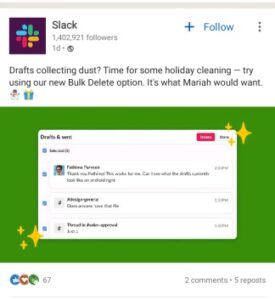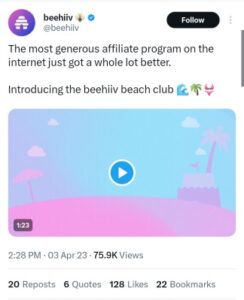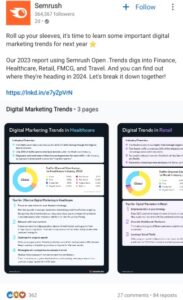B2B SaaS social media for SaaS has evolved from sharing links to blog posts and webinars to interacting and closing deals with buyers.
In 2023, a substantial 60% of B2B marketers in the United States identified social media as the leading channel for driving revenue. This trend is particularly noticeable as B2B SaaS companies leverage LinkedIn, with many founders strategically utilizing their personal brands to attract and convert leads.
The crucial question is: “How can I improve the ROI of my SaaS social media strategy?” The answer lies in tracking metrics aligned with SaaS marketing goals, creating compelling content, and mastering the art of promoting your product on social platforms without overwhelming your audience with overt sales pitches.
Let’s explore how you can achieve better results on social media and boost ROI in 2024.
How Can You Improve Your Social Media for SaaS Marketing To Boost ROI In 2024?
Improvement begins with auditing past efforts, elevating reports, and strategizing for better performance.
We divided the process into three stages to make it actionable:
PRE-LAUNCH
The “pre-launch” stage involves the foundation of social media marketing. Consider this the behind-the-scenes work of a successful social media launch—going back to the basics to ensure that output drives results. It covers the essential tasks that set your SaaS team in motion to help:
Understand why you’re using social media marketing.
Determine which strategies and tactics to use, test, or postpone.
Guide your team in execution to ensure alignment with your overall SaaS marketing goals.
To begin,
1. Conduct a social media audit:
A social media audit identifies the success and failure of a social media strategy, including platforms and campaigns. To conduct a successful social media audit:
- Audit the overall social media strategy
- Review the brand accounts, including the founder’s page if your founder has a personal brand
- Measure past content performance to learn successful and unsuccessful content
- Measure and compare results of past campaigns
- Analyze results and categorize them under strengths, weaknesses, and opportunities.
As a B2B SaaS marketer, focus on the content, platform, and tactics aligned with SaaS marketing metrics. Questions like “What content supported signups?” “Does the engagement rate contribute to website traffic?” should guide your assessment.
Attribution tools such as Sprout social tool, Google Analytics, and Dreamdata can help review your data.
2. Set new goals aligned with SaaS marketing metrics:
The point of social media for SaaS is to facilitate the SaaS sales funnel, from discovery to conversion. Create new goals aligned with your marketing goals based on the audit report. For example, if your marketing goal for Q1 includes acquiring more inbound leads through content while reducing customer acquisition cost (CAC) and your audit reveals you published two lead-generation posts on LinkedIn, your social media goal could be to publish more nurturing and lead-generating content that supports inbound leads.
To set new goals:
- Define your marketing goals.
- Review the social media audit to identify weaknesses and opportunities to leverage.
- Set a clear B2B SaaS social media marketing goal aligned with your overall marketing goals.
- Align your social media marketing goals with all stages of your B2B SaaS sales funnel.
- Set priorities based on your Ideal Customer Profile (ICP) to ensure tactics align with the buyer’s journey.
3. Leverage platforms with potential SaaS buyers:
LinkedIn remains the top-performing B2B SaaS marketing channel, generating 80% of B2B marketing leads. X (formerly Twitter) is included as a B2B social platform with 82% of B2B content teams. It’s best to decide based on your ideal SaaS buyer and budget. To effectively leverage social media for SaaS marketing:
- Select 2-3 platforms where you might find your ideal buyer, with LinkedIn being optimal for B2B SaaS buyers and Meta as a secondary consideration.
- Choose platforms that align with your content marketing goals and formats. For example, if educational content is part of your overall content marketing strategy, YouTube can serve as an additional social platform.
- Revamp brand accounts to communicate value to page visitors.
- Optimize founder’s accounts on the selected platform(s), especially for founders building a personal brand, as it contributes to brand trust.
4. Establish a straightforward SaaS social media strategy:
At this point, you have identified opportunities, set new goals, and selected a platform. The next step is to establish a straightforward strategy for long-term success. Examples of SaaS social strategies to test:
- Execute paid ad campaigns for lead-generation content.
- Publish short-form video content on your Facebook feed.
- Repurpose best-performing blog posts on LinkedIn.
- Collaborate with B2B creators on LinkedIn and Meta..
- Share user feedback on social media in an interview format.
5. Establish a social media team for execution:
Connecting with an audience and aligning SaaS metrics with social strategy are elements that constitute a proficient social media team. Build a team based on goals, content formats, and budget. If you don’t have the talent you need in-house, consider partnering with an experienced SaaS marketing agency.
Essential hires for a SaaS social media team:
- B2B social media marketing strategist
- Copywriter
- B2B social media manager/ creator
LAUNCH
During the “launch” phase, engage in testing and refining tactics that align with the implemented strategy.
At launch,
1. Create compelling content:
While there is a temptation to employ aggressive sales tactics on social media, it may have adverse effects. Prioritize content that ingrains itself in the audience’s mind while effectively supporting sales.
Examples demonstrating how to accomplish it:
- Showcase feature benefits to speak to buyer’s needs
Above, Zapier shares a short video showcasing an updated feature to help users manage time while building workflows with the product. Showcase product benefits for users and potential buyers on social media to prove your SaaS’s unique selling value.
- Make it engaging and purposeful to create interactions
B2B social content should be engaging and informative. Take, for instance, a meme from Gong that injects humor while conveying how Gong can save users valuable time in crafting follow-up emails. Strategically leverage humour and interactive content to promote services in ways that ingrain the audience’s mind.
- Leverage the founder’s and employees’ personal brands to support growth and build credibility
“I’m sold on CEOs being active on social media, particularly LinkedIn. If you’re writing content about your clients and how they find success, you’re likely to attract more like them.” – Peter Captua shares how he generates over 6,000 signups using his personal brand on LinkedIn. Boost results by leveraging the personal platforms of founders and employees.
- Include storytelling and trends to evoke memories
Slack incorporates the Christmas season into its posts on the Bulk Delete feature, evoking holiday memories with the mention of “Mariah” (the renowned artist) and accompanying emojis.
2. Be Consistent:
While it may sound cliché, it’s a proven fact: social media algorithms prefer accounts that maintain consistency, enabling them to reach a wider audience. Establish a reliable publishing schedule, aiming for at least 4-5 posts per week to foster social media growth.
3. Create and distribute content in platform native formats
Social media has evolved into a key channel for content production and distribution. Brands are adapting by creating and sharing content in formats tailored to each platform, with an emphasis on LinkedIn and X. Platforms now prioritize content crafted specifically for them over generic content. Furthermore, platform-native content allows readers to access product details without leaving the platform, enhancing credibility. To boost content reach and establish credibility, focus on creating and distributing content native to each platform.
Here’s what I mean:
- Create native content tailored to the platform
X prioritizes longer videos for premium users, and brands like Beehiiv leverage this feature to produce content native to the platform. Instead of directing users to YouTube or a landing page to introduce its affiliate program, Beehiiv shares the explainer video directly on X, tailored to the platform’s specifications. This strategy increases engagement for Beehiiv, and viewers stay within the platform to learn about the product update.
- Distribute and repurpose content in native formats
LinkedIn carousels are a major content format on the platform, which gets 5x more clicks than any other format on the platform. Brands like SemRush
repurpose and distribute content in a carousel format that fits into the platform, other than sharing a direct blog link for readers. In this way, readers don’t exit the platform, and authority is built.
POST-LAUNCH
The post-launch stage involves meticulous data tracking and analysis, ensuring that efforts and results align with key marketing metrics. By tracking and analyzing social insights, you gain a deep understanding of audience engagement and inquiries. Overlay this data with SaaS marketing metrics, with a specific focus on how many of these engaged audiences convert into Marketing Qualified Leads (MQL)/ Sales Qualified Leads (SQL) and translate into product sign-ups.
Move beyond surface-level surface tracking. Delve into details to:
- Identify the success behind best-performing content.
- Compare engagement rate vs. product inquiries.
- Understand the most resonant content.
- Measure website traffic through page visits, content, and campaigns.
Get Started Improving Your Social Media for SaaS ROI
SaaS social media marketing is a critical channel for acquiring potential buyers. Leveraging social media as a SaaS content marketing strategy positions your brand for success. Begin by reviewing past efforts and comparing them with SaaS metrics. Focus on content and tactics that support essential SaaS KPIs, such as the number of inbound leads. Improve strategies by consistently reviewing metrics and adjusting for desired results.
Could your B2B SaaS benefit from partnering with an experienced team to improve social media strategy and execution? Let’s chat.



